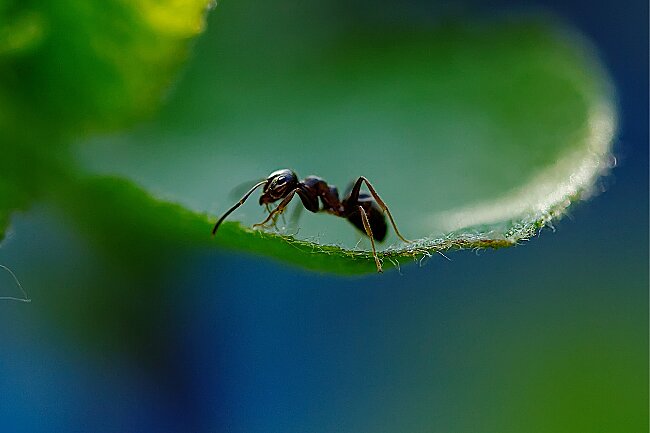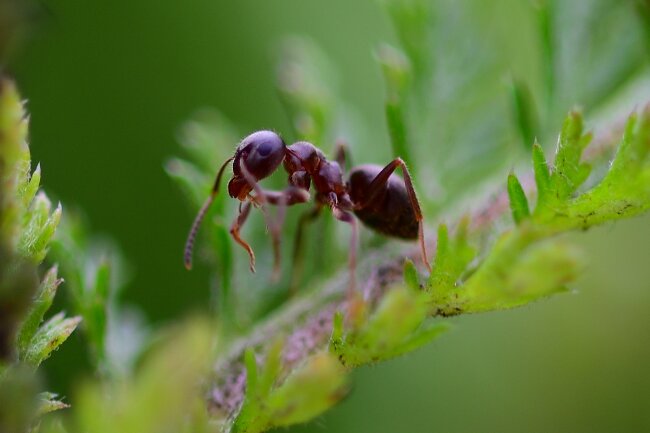Ants do poop, though their excrement is usually referred to as frass, and is generally dry and powdery. However, they do not urinate, instead, removing the moisture from their urea to create uric acid, which is excreted as a solid with their frass.
Contents
A varied diet
There are 12,000 species of ants across the world. The diet of these species varies massively. Army ants for example eat mostly insect meat, while leafcutter ants cut leaves to feed an indoor fungus garden, which they then feed off. Ants can eat fruits, pollen, honeydew from aphids, grains or meat, among other things.
Whatever they feed on, this food is then sent through their bodies, to provide them with valuable sugars, minerals, water and other useful components.
Also read: Do Butterflies have Teeth? (How do They Eat?)
Waste disposal

First, the food will be torn apart by their mandible, and enter into their mouth and down into the oesophagus. Most ant species cannot digest large pieces of food, however, and these are instead fed to the larvae, who have enzymes to help them break up these larger chunks.
Some ants will feed off liquids produced by the larvae, and one species of ant is even known to feed off the ‘blood’ of their young. Food that travels down the oesophagus can end up in the crop, also known as the ‘social stomach’. The crop doesn’t digest the food, instead, it is simply a place to store it.
Ants will often carry food in their crop to feed to other ants. This could inform another worker of the quality of food to be found if they follow the previous ant’s scent trail. Ants will also carry food to feed to important members of the colony, such as the queen.
Beyond the crop is the true stomach, where digestion occurs, and the breakdown process begins. The food then enters the hindgut, where all of the remaining moisture and nutrients are reabsorbed.
The Malpighian tubules feed into this process in order to get rid of waste from the ant’s blood (known as hemolymph). The tubes allow waste to absorb out of the hemolymph and be brought into the rest of the excrement ready to be expelled.
The unwanted leftovers will then be excreted by the ant as waste. Though this is a type of poo, the name used for ant excrement is ‘frass’.
Also read: Wondering “How Many Ants are in a Colony?” (FAQ)
Do ants pee?

Like many insects, ants do not excrete urine separately from poo. Instead, they remove all the liquid, excreting the urea, a key component of urine, as uric acid instead.
Many insects do this to avoid losing excess water. Because of their exoskeleton, they are constantly at risk of drying out, meaning they need to keep whatever moisture they can inside them.
| Species | Size | Color | Consistency |
|---|---|---|---|
| Harvester Ants | 0.04-0.08 inches | Clear | Watery |
| Army Ants | Microscopic | Transparent | Gel-like |
| Velvet Ants (Winged) | 0.04 inches | Yellowish | Sticky |
| Leafcutter Ants | 0.02 inches | Amber | Viscous |
| Bullet Ants | 0.12-0.16 inches | Dark brown | Thick, syrupy |
What does ant frass look like?
Exactly what ant frass looks like depends a great deal on what the ants eat. In general, it is powdery and dark, due to the lack of water.
The frass of carpenter ants can sometimes appear rather like wood shavings, as they have eaten so much wood that this makes up the vast amount of the waste.
Where do ants poo?

Does an ant poo in the woods? Well yes, and in the desert, in the park, probably even in our kitchen cupboards, if we are so unlucky.
When out and about, an ant can poo wherever it is. However, within the nest, they are far more fastidious. In most species, they will have a particular place that they will use as a toilet, a chamber of the nest. Some species will then remove this waste and place it outside the nest.
| Species | Size | Color | Shape |
|---|---|---|---|
| Carpenter Ants | 0.04-0.08 inches | Dark brown | Oval pellets |
| Fire Ants | 0.04 inches | Reddish-brown | Granular |
| Argentine Ants | 0.02 inches | Dark brown | Small, irregular |
| Bullet Ants | 0.12-0.16 inches | Dark brown/black | Cylindrical |
| Pharaoh Ants | Microscopic | Yellowish | Tiny, irregular |
This might seem like overkill, however, it helps to prevent the outbreak of disease within the nest itself, providing for a healthier environment. It’s the worker ants that will do the toilet duties, removing the waste of the young larvae and their queen, when required.
Also read: Do Ants Carry Disease? Can it Affect Us & How?
Ant fertiliser
While we may at first be inclined to think of it as a little gross that we may be surrounded by large amounts of other specie’s poo, in fact, most of it is entirely harmless to us, and helps to fertilise the soils we grow our food on.
Species like ants often help to cycle nutrients, by bringing food below ground and then excreting their waste into the soil. This can be a very important source of food for plants nearby, showing that in the natural world, nothing ever goes to waste.

